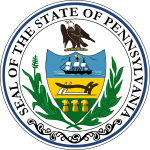| |||||||||||||||||||
All 18 Pennsylvania seats to the United States House of Representatives | |||||||||||||||||||
|---|---|---|---|---|---|---|---|---|---|---|---|---|---|---|---|---|---|---|---|
| |||||||||||||||||||
Elections to the United States House of Representatives were held in Pennsylvania on October 9, 1810, for the 12th Congress. The Federalists were in decline in Pennsylvania at this time. In six of the eleven districts there were no Federalist candidates.
Background
Eighteen Representatives had been elected in 1808, 16 Democratic-Republicans and 2 Federalists. One Democratic-Republican resigned and was replaced by another Representative from the same party, so that there was still a 16-2 division. Four of the Democratic-Republicans and two of the Federalists were "quids", a short-lived alliance of moderate Democratic-Republicans and Federalists. That was the last year in which the quids as a movement existed.
Congressional districts
Pennsylvania was divided into 11 districts, of which four were plural districts with 11 Representatives between them, with the remaining 7 Representatives elected from single-member districts. The districts were:
- The 1st district (3 seats) consisted of Delaware and Philadelphia counties (including the City of Philadelphia)
- The 2nd district (3 seats) consisted of Bucks, Luzerne, Montgomery, Northampton, Susquehanna, and Wayne Counties
- The 3rd district (3 seats) consisted of Berks, Chester, and Lancaster Counties
- The 4th district (2 seats) consisted of Cumberland, Dauphin, Huntingdon, and Mifflin Counties
- The 5th district consisted of Bradford, Centre, Clearfield, Lycoming, McKean, Northumberland, Potter, and Tioga Counties
- The 6th district consisted of Adams and York Counties
- The 7th district consisted of Bedford and Franklin Counties
- The 8th district consisted of Armstrong, Cambria, Indiana, Jefferson, Somerset, and Westmoreland Counties
- The 9th district consisted of Fayette and Greene Counties
- The 10th district consisted of Washington County
- The 11th district consisted of Allegheny, Beaver, Butler, Crawford, Erie, Mercer, Venango, and Warren Counties
Note: Many of these counties covered much larger areas than they do today, having since been divided into smaller counties
Election results
Fifteen incumbents (14 Democratic-Republicans and 1 Federalist) ran for re-election, of whom ten were re-elected. The incumbents John Ross (DR) of the 2nd district, Robert Jenkins (F) of the 3rd district and Matthias Richards (DR) also of the 3rd district did not run for re-election. Two seats changed from Federalist to Democratic-Republican control and one seat changed from Democratic-Republican to Federalist control, for a net loss of 1 seat by the Federalists. In the 1st district, there was a split between three "New School" and one "Old School" Democratic-Republicans, which split the Democratic-Republican vote enough to allow one of the three seats in that district to be won by a Federalist.
| District | Democratic-Republican | Federalist | ||||
|---|---|---|---|---|---|---|
| 1st 3 seats |
Adam Seybert (I) | 6,276 | 19.8% | James Milnor | 4,359 | 13.7% |
| William Anderson (I) | 6,218 | 19.6% | Thomas Truxton | 4,343 | 13.7% | |
| John Porter (I) | 3,143 | 9.9% | Thomas Dick | 4,269 | 13.4% | |
| Robert McMullin | 3,127 | 9.9% | ||||
| 2nd 3 seats |
Robert Brown (I) | 5,444 | 19.1% | William Milnor (I) | 4,132 | 14.5% |
| Jonathan Roberts | 5,409 | 19.0% | Levi Paulding | 4,033 | 14.2% | |
| William Rodman | 5,377 | 18.9% | William Latimere | 3,955 | 13.9% | |
| Charles Miner | 102 | 0.4% | ||||
| 3rd 3 seats |
Joseph Lefever | 6,616 | 18.4% | Daniel Hiester (I) | 5,770 | 16.0% |
| Roger Davis | 6,612 | 18.3% | Samuel Bethel | 5,437 | 15.1% | |
| John M. Hyneman | 6,201 | 17.2% | Mark J. Biddle | 5,410 | 15.0% | |
| 4th 2 seats |
David Bard (I) | 5,436 | 50.0% | |||
| Robert Whitehill (I) | 5,429 | 50.0% | ||||
| 5th | George Smith (I) | 3,576 | 100% | |||
| 6th | William Crawford (I) | 2,332 | 56.6% | David Cassat | 1,790 | 43.4% |
| 7th | William Piper | 1,428 | 58.5% | |||
| John Rea (I) | 1,015 | 41.5% | ||||
| 8th | William Findley (I) | 2,735 | 60.9% | |||
| John Kirkpatrick | 1,757 | 39.1% | ||||
| 9th | John Smilie | 1,401 | 100% | |||
| 10th | Aaron Lyle (I) | 1,344 | 70.4% | Thomas L. Birch | 564 | 29.6% |
| 11th | Abner Lacock | 2,897 | 51.0% | |||
| Adamson Tannehill | 2,455 | 43.2% | ||||
| Samuel Smith (I) | 326 | 5.7% | ||||
Post-Election
All 18 Representatives elected in October appeared in Washington at the start of the 12th Congress. John Smilie (DR) of the 9th district died December 30, 1812. Abner Lacock (DR) of the 11th district resigned February 24, 1813, after being elected to the Senate. Both had been re-elected to the 13th Congress, and both districts were left vacant for the remainder of the 12th Congress.
References
- Electoral data and information on districts are from the Wilkes University Elections Statistics Project
- ^ New School
- Old School
- Changed parties
- Quid
- "12th Congress membership roster" (PDF). Archived from the original (PDF) on December 13, 2012. Retrieved December 15, 2012.
| (1809←) 1810 United States elections (→1811) | |
|---|---|
| U.S. Senate | |
| U.S. House | |
| Governors | |
| States and territories | |
| United States House of Representatives elections | |||||
|---|---|---|---|---|---|
| Elections spanning two years (through 1879) |
| ||||
| Elections held in a single year (starting 1880) |
| ||||
| Elections by state |
| ||||
| Seat ratings | |||||
| Speaker elections | |||||
| Summaries | |||||
